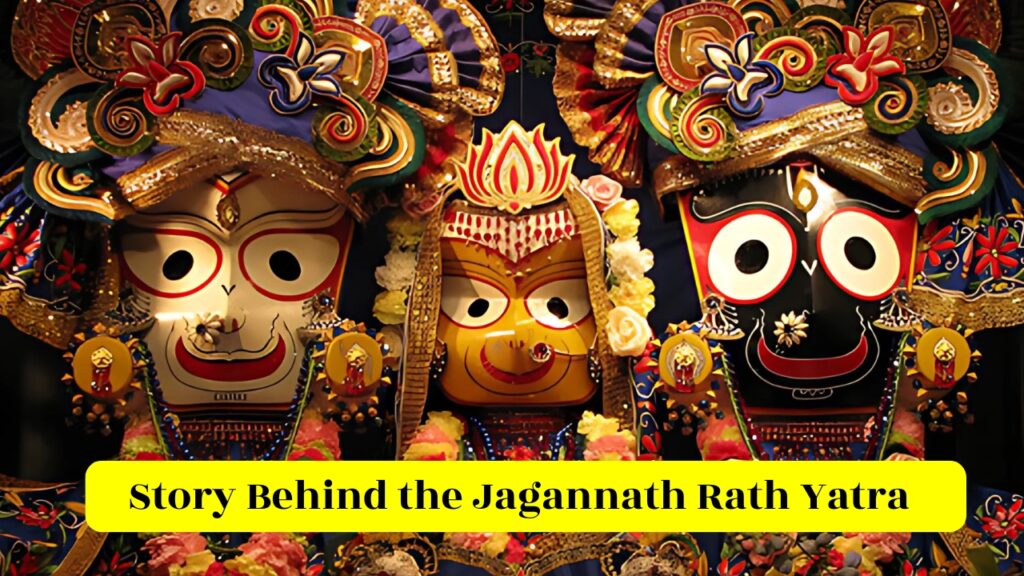The Jagannath Rath Yatra is one of the most iconic and grand spiritual events celebrated in India. Held annually in Puri, Odisha, it draws millions of devotees from all over the world. You may have seen the massive wooden chariots, the sea of people pulling the ropes with unmatched devotion, and the vibrant festivities that surround this sacred event. But beyond the grandeur lies a deeper, lesser-known story—one that carries centuries of devotion, spiritual meaning, and divine mystery.
This article unveils the real story behind the Jagannath Rath Yatra—something that goes far beyond what meets the eye.
What is the Jagannath Rath Yatra?
The term “Rath Yatra” literally means “chariot festival”. Every year, Lord Jagannath, along with his siblings Balabhadra and Subhadra, comes out of his main temple in Puri to visit his aunt’s temple—Gundicha Mandir. For nine days, the deities leave their sanctum and stay at Gundicha Temple before returning in a return procession known as Bahuda Yatra.
But why does the Lord step out of his temple once a year? What is the origin of this tradition? And what deeper truths does it reveal?
The Divine Characters of Jagannath, Balabhadra, and Subhadra
Lord Jagannath is considered a form of Lord Krishna, an avatar of Vishnu. His elder brother Balabhadra represents Balarama, and their sister Subhadra represents the divine feminine power. All three are worshipped together in the Jagannath Temple, which is considered one of the Char Dham pilgrimage sites.
Interestingly, the idols of the deities are carved from wood, unlike most Hindu temples where idols are made from stone or metal. The faces are incomplete and the limbs are symbolic, representing divine mysteries that even scholars have yet to fully understand.
The Hidden Legend Behind Rath Yatra
The story behind the Rath Yatra begins not with the festival but with deep divine emotion. According to ancient legends, after Lord Krishna departed from the world, his body was cremated, but his heart did not burn. It remained intact and was said to carry all the love, suffering, and experiences of his lifetime.
Lord Vishnu instructed King Indradyumna of Odisha in a dream to build a temple and carve new idols of Krishna, Balarama, and Subhadra out of a sacred wood that would be brought by the sea. The heart of Krishna, preserved as a mystical substance, was to be installed inside the idol of Lord Jagannath.
This process had to be done secretly by a divine sculptor who warned that the door should not be opened until the idols were complete. However, driven by anxiety and curiosity, the queen opened the door midway, and the sculptor disappeared. What remained were the unfinished idols, which we see even today—with round eyes, no hands, and no feet.
This tale explains why Lord Jagannath’s idol is different and adds emotional depth to the Rath Yatra. When the Lord comes out of his temple, he is essentially reuniting with the people—offering them darshan without barriers.
Why the Deities Visit Gundicha Temple?
According to one belief, Gundicha Temple is the birthplace of Lord Jagannath. During the Rath Yatra, the deities are carried to Gundicha Mandir where they stay for seven days, symbolizing a family visit to their maternal home.
Another interpretation is that the visit to Gundicha is a journey from material existence to spiritual liberation. The Rath Yatra represents the movement of the soul (the Lord) from worldly attachment (the temple) toward liberation (Gundicha), and back again—reminding us of the cycles of life.
The Significance of the Chariots
Each deity has their own massive, beautifully decorated chariot made of specific wood and built anew every year. The construction starts months in advance and follows strict rituals.
- Nandighosa – Lord Jagannath’s chariot, 45 feet high with 16 wheels
- Taladhwaja – Balabhadra’s chariot, 44 feet high with 14 wheels
- Darpadalana – Subhadra’s chariot, 43 feet high with 12 wheels
The chariots are not pulled by professionals, but by devotees from all walks of life. It is said that even touching the rope is a blessing, and pulling it brings immense spiritual merit.
A Unique Festival of Equality
One of the most beautiful aspects of the Rath Yatra is its message of equality. In many temples, only priests and certain individuals can touch the deity. But during Rath Yatra, the Lord comes out to the street, allowing everyone—regardless of caste, creed, or background—to touch the chariot, bow before the deity, and even offer prayers.
This reflects the concept of universal love and inclusivity in Hinduism.
The Ritual of Snana Purnima
Before the Rath Yatra begins, there is a ritual called Snana Purnima, when the deities are bathed with 108 pots of sacred water. After this bathing ritual, the idols are believed to fall ill and are kept in isolation in a chamber called the Anasara Ghar for about 15 days. During this period, no one is allowed to see them.
This phase symbolizes how even the divine form experiences human-like emotions and conditions. It creates a deep connection between the deity and the devotee, blending divinity with humanity.
The Return Journey – Bahuda Yatra and Suna Besha
After their stay at Gundicha Temple, the deities return to the main temple in a return procession known as Bahuda Yatra. On the way back, they stop at Mausima Temple to accept offerings of sweet pancakes called poda pitha.
One of the most visually captivating events happens during this phase—Suna Besha, when the deities are adorned with gold ornaments and jewelry while sitting on their chariots. This is a moment of divine celebration where the Lord is seen in his full glory.
A Festival of Global Recognition
The Jagannath Rath Yatra is not just a religious event—it has become a global symbol of faith. The International Society for Krishna Consciousness (ISKCON) organizes Rath Yatra processions in major cities like New York, London, Sydney, and Moscow, where thousands of people come together to pull the chariots and sing bhajans in unison.
It is one of the few Hindu festivals that has crossed cultural and geographic boundaries with such devotion and enthusiasm.
Conclusion
The real story behind the Jagannath Rath Yatra is not just about pulling chariots or attending a festival. It is about experiencing the Lord as a living being who feels, connects, travels, and celebrates with his devotees.
It is about the journey of life, the importance of humility, and the celebration of equality. Lord Jagannath reminds us that no matter who we are or where we come from, the divine walks among us and is always ready to embrace us in love and compassion.
If you ever get a chance to witness the Rath Yatra in person, do not miss it. It is not just a festival—it is a divine experience that stays with you forever.


